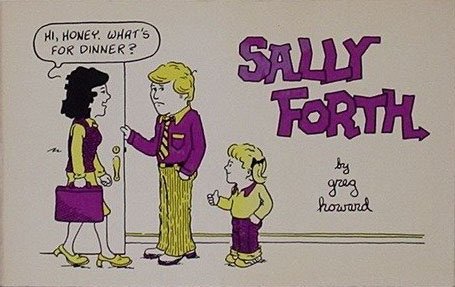Sally Forth is a comic strip that has captivated readers for over four decades, offering a combination of humor, relatable characters, and a candid look at modern-day family life. What began as a simple comic strip in 1982, created by Greg Howard and later taken over by Bill Schorr, has since evolved into a cultural touchstone, beloved by fans across generations. Sally Forth’s charm lies not only in its witty dialogues and humorous situations but also in its remarkable ability to tackle real-life issues, including family dynamics, workplace challenges, and personal growth, all while maintaining a lighthearted and accessible tone.
Sally Forth’s Humble Beginnings
The comic strip first appeared in newspapers across the United States in 1982, created by Greg Howard, who was also a writer and editor. Howard envisioned the character of Sally Forth as a modern, strong woman who balances the challenges of a career, motherhood, and a fulfilling personal life. Sally is a working mother who navigates the ups and downs of everyday life with her husband, Ted, and their daughter, Hilary.
The strip was groundbreaking in its portrayal of a working woman, something that was not common in the comic world at the time. In a period when many comics focused on either domestic life or the humorous antics of children, Sally Forth broke new ground by offering a fresh perspective on what it means to be a working mother. The comic resonated with a wide audience, particularly women, who could relate to the pressures of balancing professional responsibilities with raising a family.
Sally’s character was a welcome change from the stereotypical “housewife” figure commonly seen in cartoons. The comic strip explored not only the funny moments that come with raising a family but also the real struggles and complexities of balancing a career, managing family life, and maintaining a sense of individuality.
The Characters That Bring the Strip to Life
At the core of Sally Forth is its diverse and well-crafted set of characters. While Sally is the central figure, the strip truly comes to life through her interactions with her family, friends, and colleagues. Sally’s husband, Ted, is a loving but sometimes clueless father who provides much of the comic relief in the strip. His funny but often misguided actions serve as a perfect foil to Sally’s more pragmatic and grounded personality.
Then there’s Hilary, their teenage daughter, who brings the challenges of adolescence into the family dynamic. Hilary’s relationship with her mother is one of the most relatable aspects of the comic, as Sally often finds herself navigating the difficult waters of raising a teenager. Their mother-daughter interactions showcase both the tenderness and the frustration of parenting, which resonates with readers who are themselves parents or caregivers.
Over the years, the comic has introduced other recurring characters, including neighbors, co-workers, and friends, each contributing their own quirks and humor to the storyline. These characters have allowed Sally Forth to delve into various social issues, from workplace challenges and gender dynamics to personal growth and the evolving nature of family relationships.
For instance, Sally’s co-workers often provide humorous insights into office culture, while her interactions with friends and neighbors offer a window into her personal life outside of work. These secondary characters help flesh out the world of Sally Forth and provide additional opportunities for humor and reflection on modern life.
The Evolution of Sally Forth: Adapting to the Times
While the core premise of Sally Forth has remained consistent, the comic strip has adapted to the changing times and societal shifts. In 2006, Bill Schorr, a talented cartoonist, took over the artistic duties of the comic, bringing his own unique style to the characters. Schorr’s influence can be seen in the updated visual look of the strip, which retains its charm but feels more contemporary and polished.
The transition from Greg Howard to Bill Schorr marked a turning point for Sally Forth, as Schorr introduced subtle changes to the visual storytelling that aligned with evolving artistic trends. The characters were given a more modern look, and the artwork was refined to appeal to a new generation of readers while still holding onto the essence of the original strip.
Moreover, the comic strip has adapted to the digital age. While it started as a print-only feature in newspapers, Sally Forth now enjoys an active online presence. Readers can follow the strip on social media platforms, and digital archives of the comic provide access to decades of past storylines. This transition to digital platforms has allowed Sally Forth to maintain its relevance and continue to reach a broader audience, particularly among younger readers who may not have grown up with print newspapers.
This digital shift has also given Sally Forth the ability to engage with fans in real-time. Through social media, readers can interact with the comic, share their thoughts, and even submit their own suggestions for storylines. This two-way communication between the creators and the fans has helped the comic strip remain fresh and relevant while keeping its connection to its loyal following intact.
Reflecting Modern Family Life
One of the reasons why Sally Forth has continued to thrive is its ability to reflect the changing dynamics of family life. As society has evolved, so too have the characters and themes explored in the strip. Sally, for example, is no longer just a working mom trying to balance her career and family life. Over time, she has grown as a character, confronting new challenges that mirror the evolving roles of women in the workplace, the rise of social media, and the changing nature of family structures.
In recent years, the comic has explored more complex themes, including Sally’s pursuit of personal fulfillment outside of her career and motherhood. This shift reflects the growing awareness of mental health, self-care, and the importance of maintaining a healthy work-life balance. Sally’s struggles to maintain her individuality in the face of her multiple responsibilities are themes that many readers can relate to, particularly in an era where the pressures on women to “have it all” can sometimes feel overwhelming.
Additionally, the comic strip has begun to touch on broader societal issues, such as workplace discrimination, gender dynamics, and the challenges of navigating the modern job market. These topics are explored with the same lighthearted touch that defines the strip, allowing the comic to engage with more serious issues while still maintaining its humor and charm.
Why Sally Forth Still Matters
In today’s fast-paced, often stressful world, where the demands of work, family, and personal life are constantly pulling people in different directions, Sally Forth offers a comforting and humorous take on these struggles. The strip’s ability to blend comedy with real-life issues is one of the key reasons why it continues to resonate with readers of all ages.
Sally Forth provides an escape from the daily grind. In a world that can sometimes feel overwhelming, the comic serves as a reminder that it’s okay to laugh at life’s challenges and that you’re not alone in facing them. Sally’s witty, often exasperated expressions in the face of everyday chaos resonate with readers who find themselves in similar situations.
The comic’s humor is not just about making people laugh but also about creating a sense of understanding and connection. By tackling issues like parenting, work-life balance, and family dynamics in an accessible way, Sally Forth offers its readers a chance to reflect on their own lives, all while enjoying a good laugh.
A Cultural Icon
Over the years, Sally Forth has grown into more than just a comic strip—it has become a cultural icon. Through its long-running popularity, the strip has paved the way for other comics that explore similar themes, from family and work to relationships and personal growth. Sally Forth is a trailblazer in the world of comic strips, as it tackled issues that were rarely explored in the mainstream at the time of its inception.
The comic’s ability to grow and adapt while staying true to its roots is what sets it apart from other comic strips. It has remained relevant by reflecting the changes in society, from shifting gender roles to the rise of technology and social media. In doing so, Sally Forth has managed to appeal to multiple generations, allowing it to maintain its loyal fan base while attracting new readers along the way.
Sally Forth’s Lasting Legacy
As we look toward the future, the legacy of Sally Forth seems secure. The comic’s ability to connect with its audience on a personal level ensures its place in the comic world for years to come. Whether through the daily strip in newspapers or its growing online presence, Sally Forth continues to provide humor, insight, and a welcome escape for readers around the world.
For many, Sally Forth isn’t just a comic strip—it’s a friend, a confidant, and a source of laughter during the toughest of times. As long as people continue to navigate the challenges of balancing work, family, and personal life, Sally Forth will remain a comic that resonates deeply with those who need it the most.







